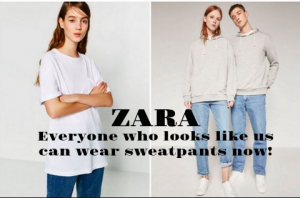Culture Jam Assignment
Rachel Sargeant
GRSJ300 99A
Oct.15, 2018
Part 1: ZARA ‘Ungendered’ Clothing Line

Part 2: Analysis
When major retailer ZARA released an ‘ungendered’ clothing line, it seemed like a big step towards breaking the boundaries of traditional mainstream fashion. However, when the campaign was released, there was outrage at the eight pieces of plain, traditionally masculine type clothing items being marketed on thin white models. Not only is this an insult to female genders, as the grey tshirts, baggy jeans and sweatpants were only cut for one body type, but to the diversity that fashion often represents. Retailers may carry unisex pieces, but anything gender neutral tends to end up being in the men’s section, labelling men as the ‘neutral’ position. Whatever gender you identify with should not be corralled into a plain, male category. ‘Gender neutral’ does not mean ‘without female identifiers’ as stores seem to think, or skirts and dresses would be termed ‘gender neutral’ a long time ago. As well, these pieces ZARA created are super boring. I’m sure genderless or non-bianary people would like colour and pattern in their lives as well, not to mention have clothing that fits whatever body they have. While sweatpants may fit most bodies, the utter disregard for fit, colour, or shape in these ‘genderless’ clothes is insulting to anyone who wants to wear more than basic loungewear. Not to mention, there were only traditionally thin, white models in the ad campaign that very clearly represented male and female. If you come out with a genderless line, would it not be a smart idea to have someone representing the line who looks like what you want to represent? Having an ‘ungendered’ line of clothing is very doable, but retailers need to listened to what gender-nonconforming people want in their clothing. It looks to me that ZARA was trying to brag about being inclusive but ended up really harming their reputation.
Part 3: Jammed Ad

Part 4: Explanation
In my altered ad, I wrote down what ZARA’s clothing line was saying to me personally. ‘Everyone can looks like us can wear sweatpants now!’ is a combination of what the physical clothing is and a spin on one of my first ideas “Finally women can wear lounge pants and not be called masculine”. As someone who regularly dresses androgynously, I find myself dressing in ‘men’s’ clothing to achieve the look. While things like button down shirts, jeans, and yes, sweatpants, are worn all genders, the cuts, fits, and style of them differ for female and male bodies. If there was going to be a line of un-gendered white tshirts, there could at least be more than three sizes and multiple cuts for various body shapes for nonbianary people with wide shoulders or trans men with hips. In my jammed ad, I’m looking to point out how narrow the open-mindedness of the ungendered line of clothing really is. I’d like the draw attention to the lack of body types and ethnicities in the campaign by the ‘everyone who looks like us’ line, and pointing out the lack of actual clothing pieces (besides basic tshirts and lounge pants) designed for the line that look cool, casual, or sleek and can be worn in daily outside scenarios. To me, clothes like what ZARA is promoting are for staying at home on a couch, not for going to events, shopping, or work. I’m frustrated at this ad and I want people to be offended at the original as well as at my jam ad. Bringing attention and curiosity to non-cisgendered people, non-bianary people, and genderfluid individuals is a way to have conversations about sexuality and gender, but ZARA’s campaign only shows what one person who has obviously not done research about what ‘genderless’ actually means nor talked to a nonbianary person about how the campaign would affect them.